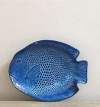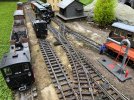You are using an out of date browser. It may not display this or other websites correctly.
You should upgrade or use an alternative browser.
You should upgrade or use an alternative browser.
Fish Plates
- Thread starter DafyddElvy
- Start date
DafyddElvy
1:22.5 & 15mm Scale Trams, , NG Steam Railways
A wee thread drift on to rail lengths is still more or less on topicIn some ways, i can understand why someone might want to depict a more realistic type of rail joint .................... but then we'd be into a discussion about what a prototypical length of rail should be and how frequently they should be spaced
Chris Vernell
45.29 N, 75.75 W
And how many working model gangers one would need to lift such lengths.A wee thread drift on to rail lengths is still more or less on topic


DafyddElvy
1:22.5 & 15mm Scale Trams, , NG Steam Railways
You'd only need 1 ganger but the number of plate layers would depend on the length of rail being movedAnd how many working model gangers one would need to lift such lengths.
maxi-model
UK/US/ROW steam narrow gauge railways 1:1
View attachment 304240
Dunno what scale this is.
Oh ! Fish plates ! I gedit. I was thinking fish heads
Gavin Sowry
Garden Railroader and Raconteur
Blue.View attachment 304240
Dunno what scale this is.
Gavin Sowry
Garden Railroader and Raconteur
Since you asked, 39' for American rail. That is so that the rail can fit on the once standard 40' long flat wagon. English, 60' is common, I believe.In some ways, i can understand why someone might want to depict a more realistic type of rail joint .................... but then we'd be into a discussion about what a prototypical length of rail should be and how frequently they should be spaced
In NZ we went for 42', because that's what you could fit in a ship's hold. When American was all we could get during/after the war, we had American ASCE and ARA sections, in 39' lengths.
Yes but what shade of blue?Blue.
JimmyB
Now retired - trains and fishing
If it is for electric trains thenYes but what shade of blue?
Blue, Blue, Electric Blue
PhilP
G Scale, 7/8th's, Electronics
Look's more Caledonian, than BR, to me?Yes but what shade of blue?
PhilP
Greg Elmassian
Guest
From Wikipedia:
A fishplate, splice bar or joint bar is a metal connecting plate used to bolt the ends of two rails into a continuous track. The name is derived from fish, a wooden reinforcement of a "built-up" ship's mast that helped round out its desired profile.
Nothing to do with angles I believe...

 en.wikipedia.org
en.wikipedia.org
I think you will see the first fishplate had no angles.
Greg
A fishplate, splice bar or joint bar is a metal connecting plate used to bolt the ends of two rails into a continuous track. The name is derived from fish, a wooden reinforcement of a "built-up" ship's mast that helped round out its desired profile.
Nothing to do with angles I believe...

Fishplate - Wikipedia
I think you will see the first fishplate had no angles.
Greg
JohnSol
Registered
Maybe yes, maybe not.... the question is: what's prototypical? From mainline to out-of-the-way short lines, I've seen numerous variations in rail coupling.Huh, far from prototypical.
Expansion: US mainlines utilize continuous welded rail. How they compensate for expansion is a mystery to me.
A lot of room at the termini for the rails to stretch to?Maybe yes, maybe not.... the question is: what's prototypical? From mainline to out-of-the-way short lines, I've seen numerous variations in rail coupling.
Expansion: US mainlines utilize continuous welded rail. How they compensate for expansion is a mystery to me.
Gavin Sowry
Garden Railroader and Raconteur
Not to me, but, I'm off for a day 'playing trains', I'll explain later when I get home.Expansion: US mainlines utilize continuous welded rail. How they compensate for expansion is a mystery to me.
Basically, forget the theory of linear expansion, that mainly applies to unrestrained steel. The fastenings, sleepers and ballast all play a big part in keeping the track straight and true.
Greg Elmassian
Guest
Of course curves let most of the expansion go, they move.
long straight track is still a wonder to me. Must be laid with enough gap to compensate, but how about 1/4 mile of welded rail?
The answer is at what temperature the rail is laid at (pretty high) and sometimes the rail does have to be cut, shortened and re-welded.

 worldwiderails.com
worldwiderails.com
Greg
long straight track is still a wonder to me. Must be laid with enough gap to compensate, but how about 1/4 mile of welded rail?
The answer is at what temperature the rail is laid at (pretty high) and sometimes the rail does have to be cut, shortened and re-welded.

How Do Railroads Deal With Thermal Expansion? | Worldwide Rails
How do railroads deal with thermal expansion? Railroads deal with thermal expansion by heating the rail prior to installation. Therefore, the rail
 worldwiderails.com
worldwiderails.com
Greg
JimmyB
Now retired - trains and fishing
In the UK with welder rail, according to temperature at time of fitting and the length, a gap is cut in the track, and the track stretched to fit before welding, ends up as a similar principleOf course curves let most of the expansion go, they move.
long straight track is still a wonder to me. Must be laid with enough gap to compensate, but how about 1/4 mile of welded rail?
The answer is at what temperature the rail is laid at (pretty high) and sometimes the rail does have to be cut, shortened and re-welded.

How Do Railroads Deal With Thermal Expansion? | Worldwide Rails
How do railroads deal with thermal expansion? Railroads deal with thermal expansion by heating the rail prior to installation. Therefore, the railworldwiderails.com
Greg
Gavin Sowry
Garden Railroader and Raconteur
That attachment sums up what I've been thinking about how to explain things all day while at a GR meet.Of course curves let most of the expansion go, they move.
long straight track is still a wonder to me. Must be laid with enough gap to compensate, but how about 1/4 mile of welded rail?
The answer is at what temperature the rail is laid at (pretty high) and sometimes the rail does have to be cut, shortened and re-welded.

How Do Railroads Deal With Thermal Expansion? | Worldwide Rails
How do railroads deal with thermal expansion? Railroads deal with thermal expansion by heating the rail prior to installation. Therefore, the railworldwiderails.com
Greg
First of all, understand the concept of SFT Stress Free Temperature. In NZ we use a SFT of 32°C. That means when the rail is at that temperature, the steel is in its natural state.
Either side of that, the rail trys to expand or contract. To contain this, movement of the rail is held by fastenings with the sleeper. This transfers the thermal forces to the sleeper. Spring clips, such as Pandrol etc. are very good at this, dog spikes are pretty poor, that is why rail anchors are used hard up against each side of the sleeper. All this energy going into the sleeper is dissipated by the ballast, which is why ballast profile has to be meticulously maintained. Allow any of the above to get out of whack, and you WILL get track buckles..... which in this country, I have to investigate.
The cutting and welding mentioned is usually associated with the laying or repair of CWR (or ribbon rail to our American friends). Depends on what temperature the rail is at this time relative to the SFT. To compensate for the difference sometimes a calculate length is cut out, then the rail remaining is 'stretched' back to the actual length, and welded. You never lay rail when it is too hot, because theoretically you may have to compress the rail, which you can't do, and if you fastened down the hot rail above the SFT it will actually tear apart when it cools down to very cools temperature.
Gavin Sowry
Garden Railroader and Raconteur
True.Yes but what shade of blue?


